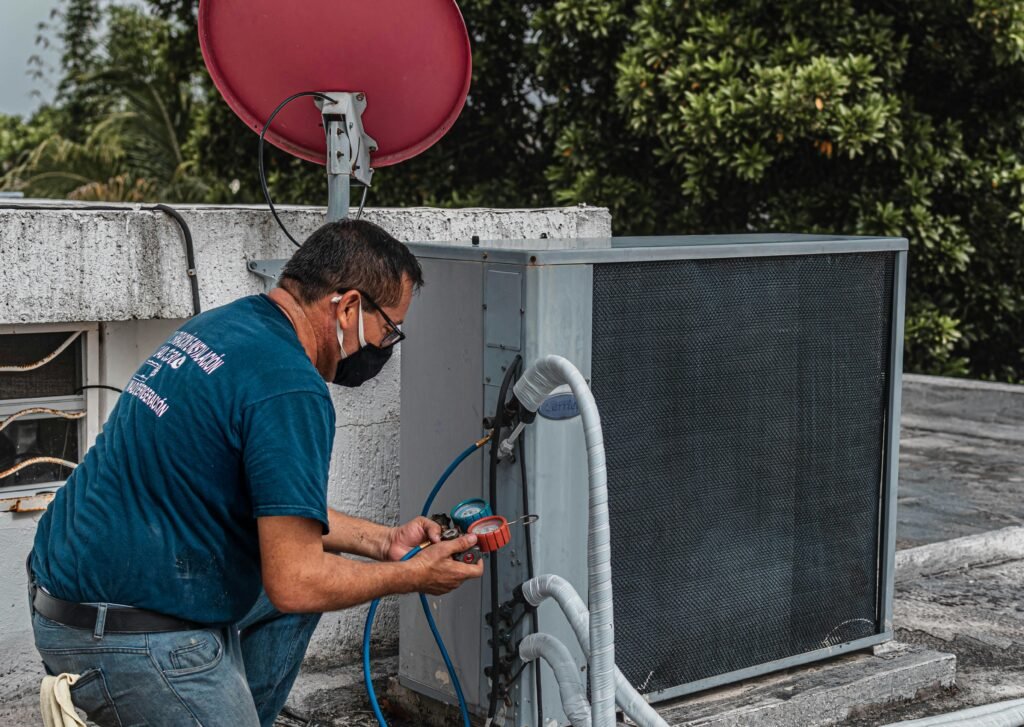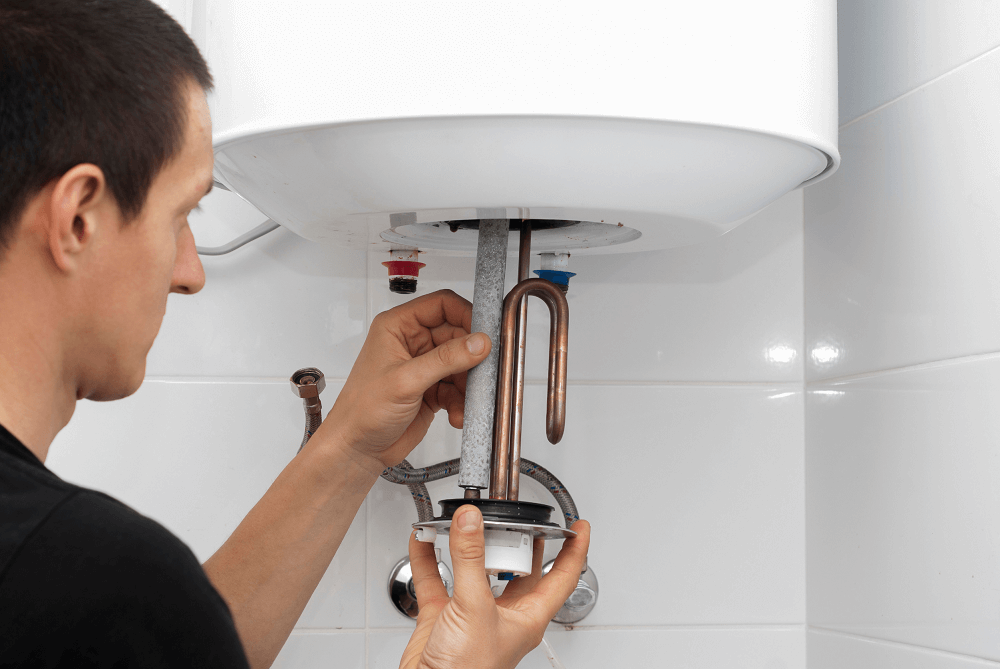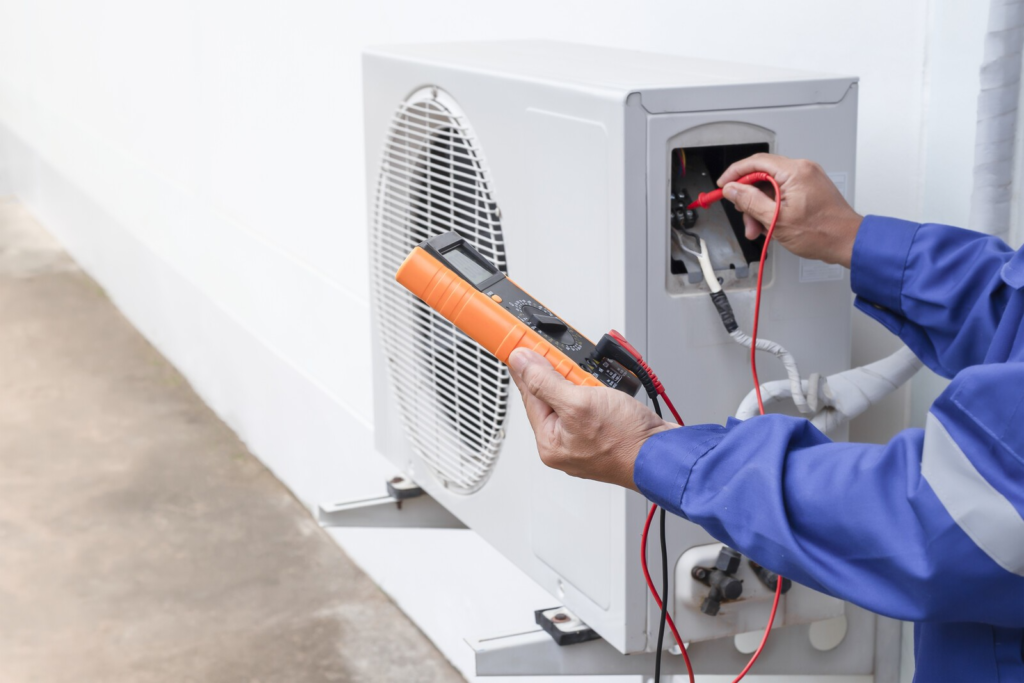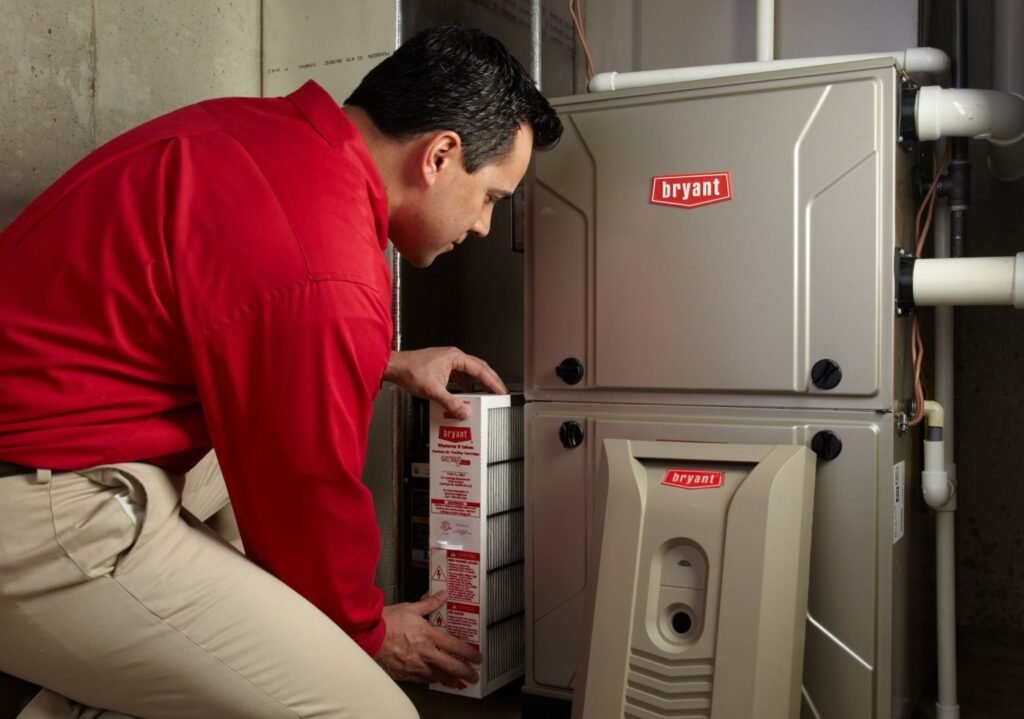Your commercial building is only as good as your HVAC system!
Canadian business owners and property managers should never overlook their commercial heating and air conditioning units; they keep their people comfortable by improving air quality and regulating temperatures. Whether it’s an office building, restaurant, hotel, or retail store, high-quality HVAC can make a huge difference.
Understanding the fundamentals of your commercial heating, ventilation, and air conditioning (HVAC) system is essential if you want to make informed decisions, reduce energy costs, and maintain its condition for years to come.
Whether you’re a seasoned professional or new to HVAC management, this resource will equip you with everything you need to know about commercial HVAC basics.
Everything You Need to Know About Commercial HVAC Systems
Commercial HVAC Systems Explained
Types of Industrial HVAC Systems
Assessing Your Commercial HVAC Needs
Energy Efficiency and Environmental Impact
Installation & Maintenance
Industrial HVAC Troubleshooting Issues
Finding Reliable Commercial HVAC Contractors
FAQs
Commercial HVAC Systems Explained
Each of the components that make up your HVAC system—heating, ventilation, and air conditioning—work together to maintain a comfortable indoor air temperature and air quality year-round.
Let’s briefly dive into each of these elements and discuss how they contribute to the overall operations of your HVAC system.
- Heating
Open Question Icon - Ventilation
Open Question Icon - Air Conditioning
Open Question Icon
Keep Reading
10 Ways to Extend the Lifespan of Your Water Heater!
10 Tips to Extend Your Water Heater’s Life
The Future of HVAC: Sustainable and Green Technology
Future of HVAC in Canada
Quiet Your Haunted House: 13 Tips to Silence HVAC Noises
Haunted by HVAC Noises? Learn How to Silence Them with Our 13 Tips!
Get a Customized Commercial HVAC Solutions Quote
Energy Efficiency and Environmental Impact – LG Home Comfort
Types of Industrial HVAC Systems
Selecting the right commercial HVAC system depends on factors like building size, layout, energy efficiency goals, and budget. It’s essential to to consult with HVAC professionals to determine the most suitable system for your specific commercial space prior to making any decisions.
The table below evaluates the most common types of industrial HVAC systems, their characteristics, and recommended use.
Type Defining Characteristics Recommended Use
Single-Split Systems ➡️ Split into single indoor unit (furnace or air handler) and single outdoor unit (condenser)
➡️ Controlled by single thermostat
➡️ Simple and cost-effective
☑️ Perfect for small commercial spaces such as individual offices, small retail shops, or server rooms where a single room or zone requires heating and cooling
☑️ Requires ductwork
Multi-Split Systems ➡️ Multiple indoor units are connected to a single outdoor unit
➡️ Reduced outdoor footprint
➡️ Allow for zoned temperature control
☑️ An excellent choice for medium to large commercial spaces, including restaurants and office suites
☑️ Requires ductwork
Packaged Rooftop Units (RTUs) ➡️ All HVAC components packaged into a single unit
➡️ Compact system, making them easy to install and maintain
☑️ Frequently used for single-storey commercial spaces, such as retail stores, restaurants, and small office buildings
☑️ Requires ductwork
Variable Refrigerant Flow (VRF) ➡️ Allow for zoned temperature control
➡️ Two types: Heat Pump VRF (for heating or cooling) and Heat Recovery VRF (for heating and cooling simultaneously)
➡️ Highly flexible and energy efficient
☑️ Best for medium to large commercial buildings with varying cooling and heating needs, such as hotels, hospitals, or mixed-use developments
☑️ Requires ductwork
Air-Source Heat Pumps ➡️ One outdoor unit with one or more indoor units
➡️ Provide both heating and cooling
➡️ Allow for multi-zone temperature control
➡️ Cost-effective and energy efficient
☑️ Small commercial spaces
☑️ No ductwork required
Boilers ➡️ Uses fuel to heat a fluid that is pumped through a hydronic heating system
➡️ Heated fluid is distributed through radiators or in-floor heating loops
➡️ Zoning capabilities
☑️ Recommended for large commercial spaces, such as warehouses, factories, hotels, and healthcare facilities that require a high heat output
☑️ No ductwork required
How to Assess Your HVAC Needs
A well-informed assessment of your commercial HVAC needs will help you select the most appropriate system, optimize energy efficiency, and ensure your commercial space remains comfortable year-round. Here are the top considerations to help you assess your HVAC requirements:
- Determine the Building Size and Layout
Sizing and capacity matter when choosing an industrial HVAC system, as systems that are too small or too large won’t run efficiently—they’ll just run up your bills. Measure the square footage of the area that needs climate control and consider the layout, including open spaces, separate rooms, and high-ceiling areas. This information will guide you in determining the type and capacity of the HVAC system required.
Example: You’re the owner of a small restaurant. Your establishment has a total floor area of 2,000 square feet, with a dining area and an enclosed kitchen. The dining area is open with high ceilings, while the kitchen requires efficient ventilation and cooling due to heat generated by cooking equipment.
Dining Area: Given the spacious, open layout and high ceilings, it’s essential to choose an HVAC unit with sufficient cooling capacity to maintain a comfortable temperature during peak dining hours. A multi-split or VRF system with zoning capabilities may be a good choice to ensure even cooling in this area.
Kitchen: The kitchen demands a separate solution, focusing on ventilation and cooling to handle heat generated by stoves, ovens, and other equipment. A specialized exhaust system and HVAC unit designed for commercial kitchens are necessary to maintain air quality and comfort.
In this example, by analyzing the size and layout of your restaurant, you’ve determined that a combination of HVAC solutions is necessary to meet the distinct needs of different areas within the same building. This tailored approach ensures efficient climate control for your specific requirements, whether it’s maintaining a pleasant dining atmosphere or providing a comfortable workspace for kitchen staff.
💡 Read more: How to Calculate What Size of HVAC Unit You Need
Get a Custom Commercial HVAC Solutions Quote
- Consider Zoning Needs
When installing an industrial HVAC system, you also need to consider the need for zone-specific temperature control. Assuming you want this, you will need to install dampers and programmable thermostats to manage temperatures.
When evaluating commercial HVAC zoning possibilities, we recommend implementing the following to ensure the best results:
Don’t create zones larger than one floor
Install individual thermostats in rooms used most often
Group rooms with similar heating and cooling loads
- Identify Your Local Climate
The geographical location of your business is an important factor to consider. Certain types of commercial HVAC systems won’t perform well in freezing conditions while others will excel. Check local climate data and consider variables like seasonal temperature extremes, humidity levels, and the number of heating and cooling days. - Analyze Occupancy and Usage
Take into account the number of people who occupy your commercial space and their activities. Spaces with high occupancy density, like restaurants or conference rooms, may require additional ventilation. Poor air quality affects productivity and can make guests uncomfortable, so ensuring air quality in commercial HVAC systems is a non-negotiable.
Also, consider whether your business operates during extended hours, as this affects HVAC usage and energy consumption.
💡 Read more: Care for Your Air: A Guide to Indoor Air Quality
A busy office space filled with employees
Energy Efficiency and Environmental Impact
Efficiency is at the heart of a well-managed commercial HVAC system. Maximizing energy efficiency not only reduces operational costs, but also minimizes your environmental footprint.
Here are the HVAC basics when it comes to sustainability:
Upgrade to High-Efficiency Equipment
When shopping for industrial HVAC units, always look for the ENERGY STAR certification label. Their blue star logo signifies a product has met strict energy-efficient guidelines set by Natural Resources Canada’s Office of Energy Efficiency. Approved models are designed to help you save money and energy while reducing your carbon footprint.
Some HVAC systems are equipped with variable speed compressors and fans to adjust their output to match the current cooling or heating demand, which saves energy compared to fixed-speed systems. Additionally, more advanced models can recover waste heat, using it to warm other parts of your building or for water heating, increasing overall efficiency!
Strategies for Reducing Energy Consumption
1. Efficient Ductwork and Insulation
Leaky ducts and poor insulation can lead to energy waste. Inspect and seal ducts, and improve insulation in your commercial space to reduce energy losses and enhance HVAC performance.
2. Install Programmable ThermostatsSet temperature schedules that align with occupancy patterns. This prevent unnecessary heating or cooling when your space is unoccupied.
3. Conduct Regular MaintenanceScheduled maintenance, including filter replacement and system checks, keeps your HVAC system running efficiently.
💡Read more: Why Is Energy Conservation Important?
Upgrade Your Heating and Cooling System and Save Up to $8,400
Professional HVAC Installation and Maintenance
You should always leave the installation and maintenance of commercial HVAC systems to the professionals. Proper care is paramount for the performance and longevity of your unit.
Here’s what you can expect from professional industrial HVAC installation at LG Home Comfort:
Commercial HVAC Installation Process
Custom Design Options: LG Home Comfort offers custom designs for specific HVAC systems, tailored to the needs of your business.
Initial Assessment: An HVAC technician will measure and assess your space, then calculate the appropriate unit size based on their findings.
Unit Placement: The indoor and outdoor units are strategically placed based on the system type and the building’s layout.
Ductwork Installation: If needed, ductwork is installed or modified to distribute conditioned air effectively throughout the space.
Electrical and Plumbing Connections: Wiring and plumbing connections are made to ensure the HVAC system’s functionality.
Post-Installation Checks
Testing and Balancing: The system is thoroughly tested to verify that it operates correctly, including checking for refrigerant leaks, air balancing, and safety tests.
Commissioning: A final check and commissioning process are performed to ensure the system’s performance meets the design specifications and provides optimal heating and cooling.
User Training: The last step in the process involves ensuring you know how to operate the commercial HVAC system for peak efficiency and results.
an HVAC contractor inspecting the vents in a commercial building
The Importance of Maintenance and Preventative Care
Regular maintenance and preventative care significantly extends the lifespan of your HVAC system, making it less prone to breakdowns and costly repairs.
Of all the HVAC basics a business owner needs to know, this is one of the most important.
Scheduled, professional HVAC maintenance can improve air quality, maintain your system’s warranty coverage, reduce your energy consumption, energy bills, and carbon emissions, and prevent unexpected breakdowns.
As with installation, commercial HVAC maintenance should be left to the professionals due to their specialized training and industry expertise. DIY efforts often lack the knowledge required to perform thorough inspections, diagnose complex issues, and calibrate equipment effectively. Professionals possess a deep understanding of HVAC systems, ensuring they can identify and rectify problems before they escalate. They also have access to the right tools and equipment to maintain safety and performance standards.
By prioritizing professional and consistent maintenance, you’ll secure the long-term performance of your commercial HVAC system, fostering a productive and energy-efficient workspace.
Schedule Professional Commercial HVAC Maintenance
Common Industrial HVAC Problems
Business owners need to stay on top of these common commercial HVAC issues to prevent disruptions in operations, discomfort and inefficiencies from happening.
Poor Airflow: Inadequate air circulation can result from clogged filters, blocked ducts, or faulty fans, leading to uneven heating or cooling.
Refrigerant Leaks: An air conditioning failing to do its job is often attributable to refrigerant leaks.
Faulty Thermostats: Inaccurate thermostats can lead to temperature discrepancies, wasting energy and affecting occupant comfort.
Ignition Issues: Your furnace not igniting properly (and therefore not heating your building) could be the result of fuel supply problems or a faulty ignitor. Neither of these are things you should try to fix yourself.
Odd Noises: Loud banging, clanging, or buzzing is your cue to call a technician. These are often the cause of issues with fans, motors, or other components.
The Cost of Commercial HVAC Systems
It’s no secret that commercial HVAC units are expensive, with prices ranging from $6,000 to $50,000. This variability is based on several factors:
Unit size and capacity
Brand, type, and efficiency rating
Additional components to cater to your building’s heating and cooling needs
Labour costs and installation fees
Market competition in your area
The good news is that commercial HVAC systems are built to last a minimum of 15 years. This can easily be extended to 20 years and beyond with regular maintenance.
Finding Reliable Commercial HVAC Contractors
Now that you understand the value of professional maintenance and installation, you’re probably wondering how to evaluate HVAC companies. Selecting the right service provider is critical for the long-term health and efficiency of your HVAC system, so we recommend you choose one based on the following factors:
Licensing & Certification
You want the best of the best when it comes to installing and maintaining your commercial HVAC system. A license, bond, and insurance will give you peace of mind that they know what they’re doing. You can also check for certification from industry organizations as a sign of expertise and professionalism.
References & Reviews
Ask for references from past clients and read online reviews. Positive feedback and a strong reputation are indicative of a trustworthy contractor.
Industry Experience
We recommend choosing an HVAC company with a proven track record of working on commercial HVAC systems. Experience with similar systems to yours is a valuable asset.
Partner With Commercial HVAC Experts at LG Home Comfort
When it comes to your commercial HVAC needs, trust the expertise of a family-owned HVAC company with a legacy of excellence.
At LG Home Comfort, we’re proud to be a Canadian-owned and operated business with decades of experience in the industry. Our dedicated team specializes in serving the unique requirements of commercial buildings, ensuring optimal climate control and energy efficiency.
We do everything—from property assessment to custom design, installation, maintenance and repairs—so that you can focus on what you do best; running a business. As one of the most reliable HVAC companies in Ontario, it’s our mission to always be available, 24/7/365, so that your operations aren’t impacted by unforeseen equipment breakdowns.
Don’t compromise on the comfort and performance of your commercial space, call LG Home Comfort today to learn more about













